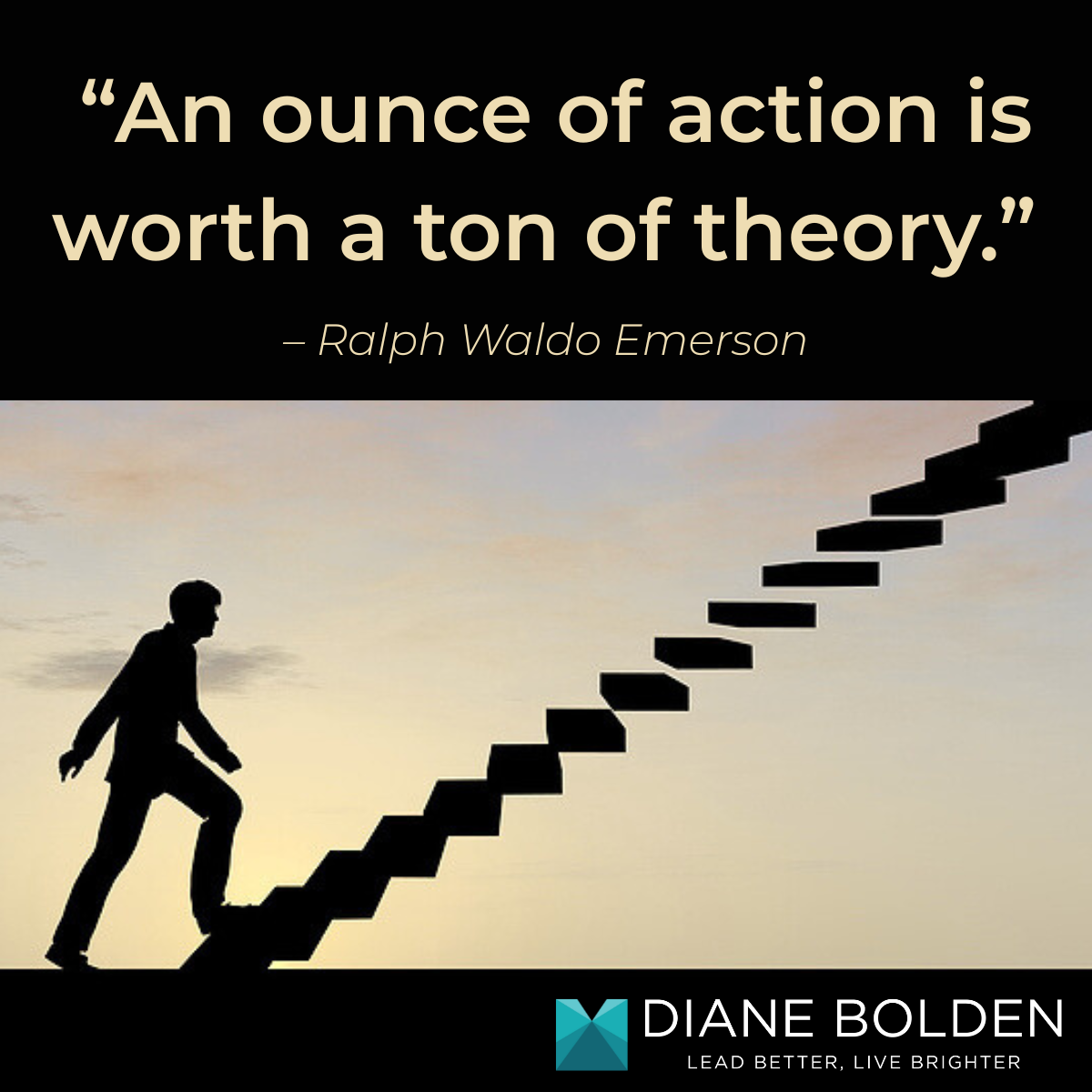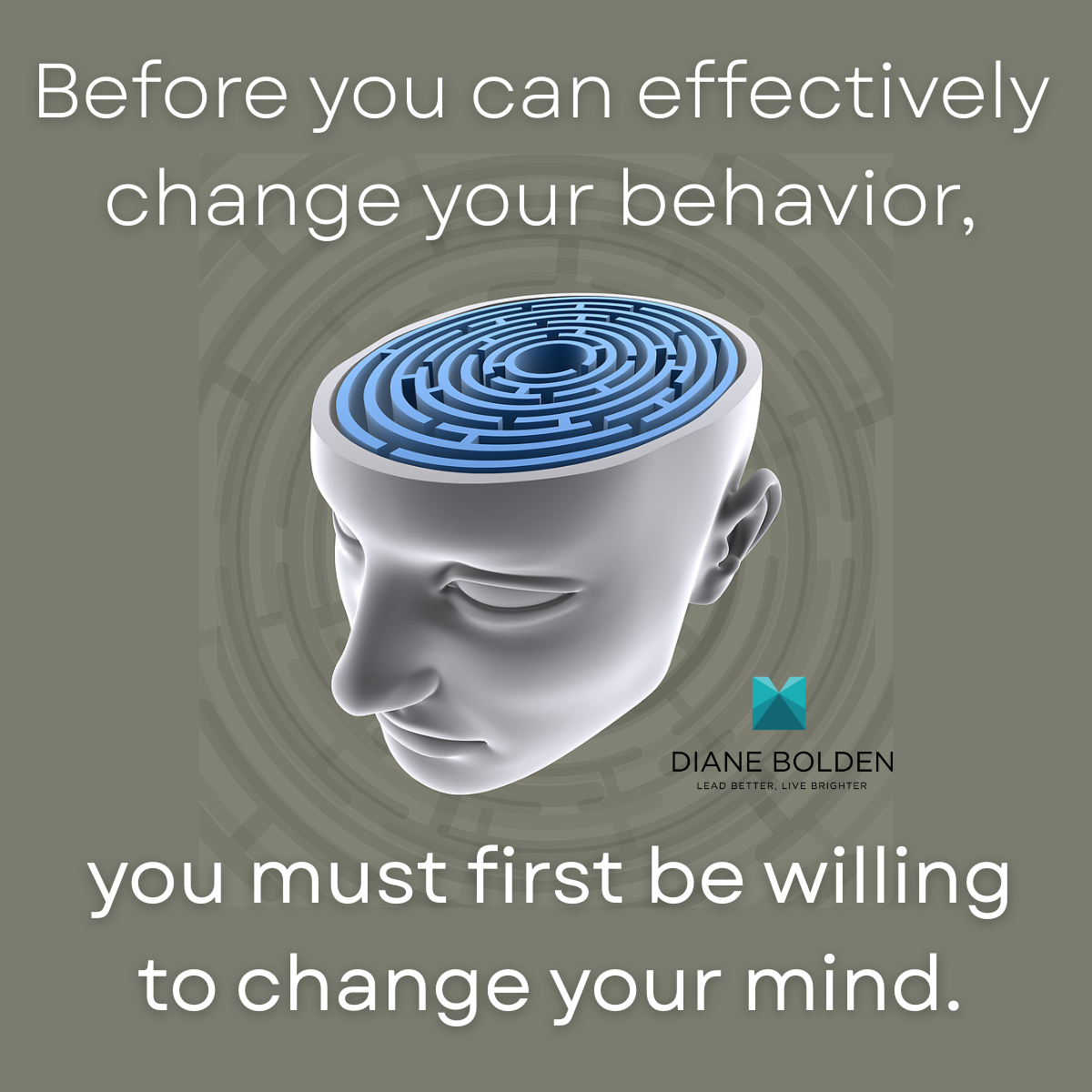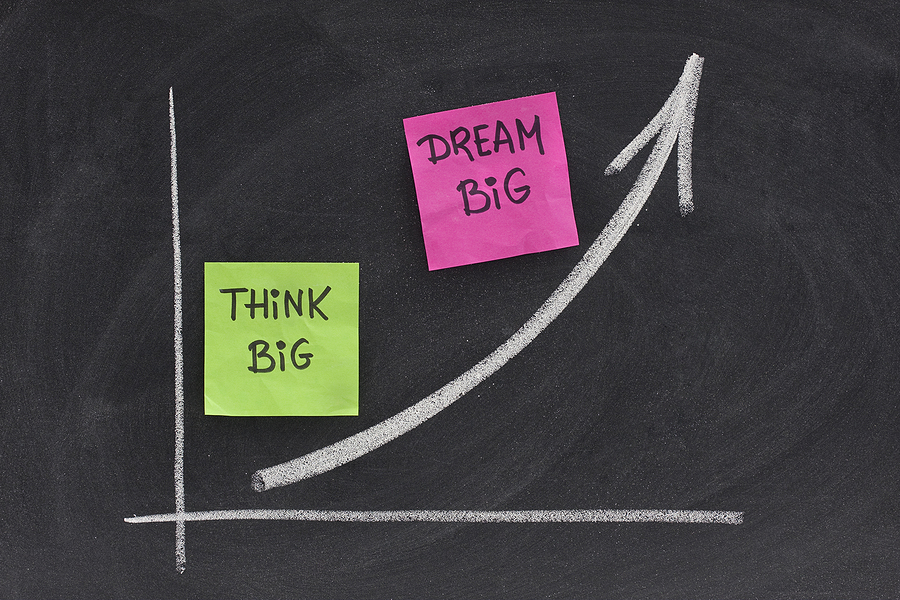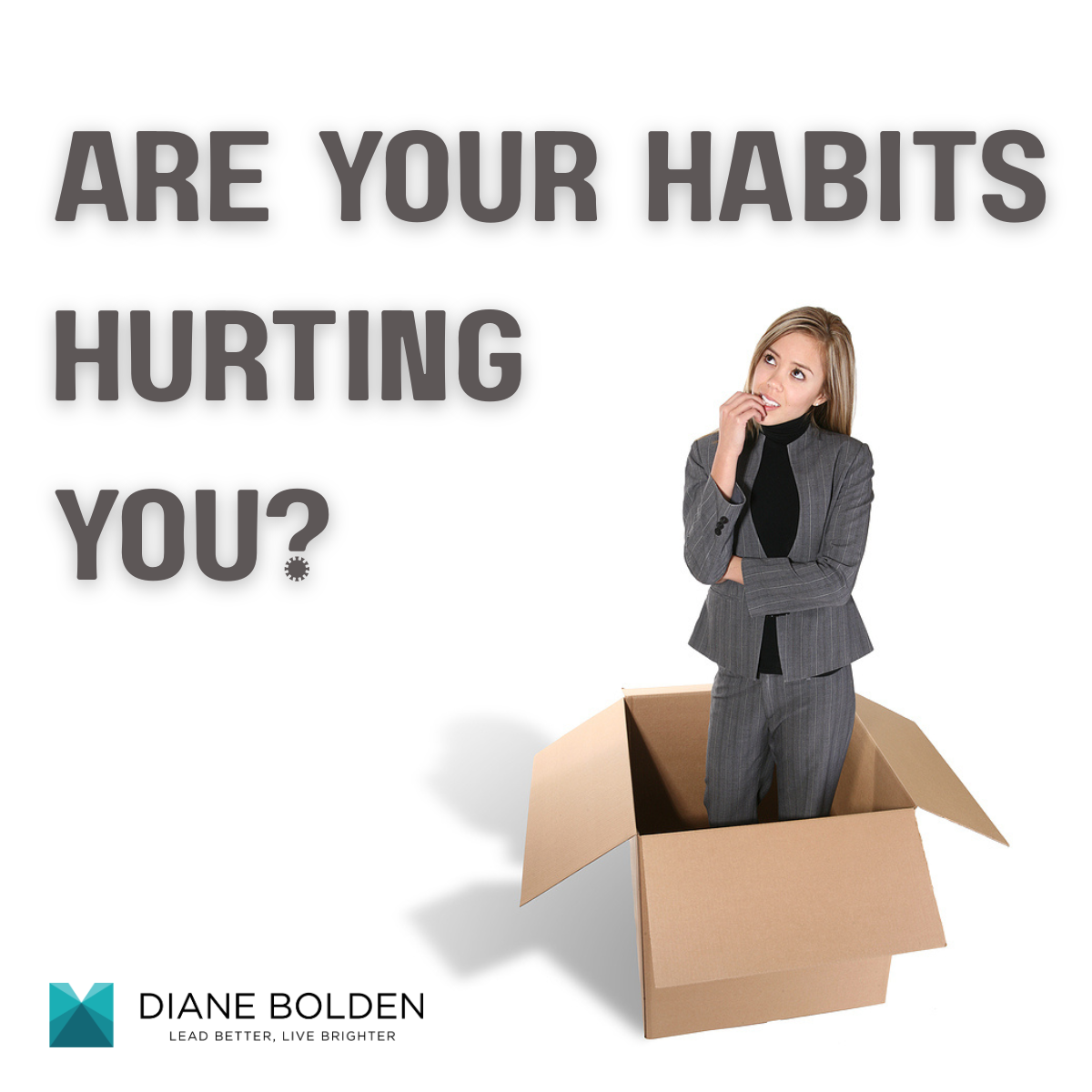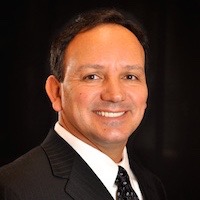Category Archives: Pinocchio Principle
How to Leverage a Cringe Worthy Moment
A step backward (even a cringe worthy moment) can be used to propel you forward – IF you know how to leverage it. This week’s video will show you how…
Here’s to your success!
Diane
How to Change a Habit That is Hurting You, Part 5
You’re committed to making a change, focused on what you’re moving toward, aware of the impact of your current behavior, and challenging the assumptions that have been driving you to it.
But there’s one last step that is crucial to your success.
Envision and practice a new way of doing things.
It is essential to substitute a new behavior for the old one so you can focus more on what you are moving toward than away from.
Chances are you already know what you’d like to do as an alternative. If not, you can ask yourself the question, “What would be a better way of handling situations that have been causing me trouble?”
When you ask a question, your subconscious mind gets busy finding the answer for you.
You may learn by watching or seeking mentoring from people around you who are masterful in the areas you strive to improve in. You may find yourself drawn to articles, books, workshops or other resources that will help you. You might journal about it and find yourself writing about the answer.
Once you have an idea of what you’d like to do differently, it’s important to practice as often as you can, both physically and mentally.
As Ralph Waldo Emerson once said, “An ounce of action is worth a ton of theory.”
Action is how you bridge the gap between the future you envision and the state you find yourself in now. But you don’t have to wait until you have all the answers or the confidence of a master to begin. Any action that serves your goal will start building momentum and allow you to learn and make essential adjustments along the way.
Remember to be patient and kind with yourself as you learn a new behavior.
It will probably be somewhat uncomfortable or, at the very least, unnatural at first. You’ll likely not be very good at it right away. And you may find it tempting to simply revert to your old behavior as a result.
But stick with it. Since discomfort accompanies growth, it is an indicator of progress.
With consistent practice, it will get easier and come more naturally, until finally the new behavior is so ingrained that you won’t have to think about it all that much.
If an action doesn’t bring the desired result, you can ask yourself what you could have done differently. Use the experience as data to fine-tune your approach to be more aligned with your desired results.
The steps I’ve been sharing with you over these last few days are a small part of what I teach and coach executives to implement in The Pinocchio Principle Unleashed, a thirteen-week, seven-module virtual leadership development program designed to help business professionals like you maximize your performance, minimize stress and pressure and enjoy a more fulfilling life both on and off the job (and lead others to do the same). Message me for more information if you are interested.
How to Change a Habit That is Hurting You, Part 4
Sometimes when you can’t kick a habit that is hurting you, it’s because your behavior is linked to a limiting assumption or belief. It’s like pulling out a weed without removing its root.
Action follows thought and assumptions are thoughts that are like the strings on puppets, controlling their every move. When these assumptions are unexamined, they propel us to engage in actions without thinking.
But when you examine the assumptions linked to a behavior you want to change, you may find that though they are compelling, they are not very logical – and in some cases are downright erroneous.
An assumption that keeps people from taking bold action could be something like “I don’t have what it takes to do what I really want to do,” or “If I try and fail, I’ll be worse off than I am now.”
And an assumption that keeps people from delegating to/empowering others and truly leading might be “If I don’t do this myself, it’s not going to get done right (or at all).”
Assumptions like these get us into more trouble than they prevent and have us acting in ways that reinforce the assumption.
In the first case, if you assume that you can’t do something, you’ll act with hesitation (if at all), and your wavering will keep you from performing or lead you to make things much harder than they need to be. You may look to your lack of results as confirmation that your assumption was correct, but the real problem is the impact the assumption itself had on your ability to act with confidence.
In the second case, if you don’t believe others can handle something (or that you are better off doing it yourself), you’ll likely not properly set them up for success, build their confidence or remove obstacles that could keep them from achieving results. And when they are unable to execute properly, you’ll see their lack of success as data that confirms your initial assumption.
Identifying these assumptions can be tricky because they’re often so engrained we don’t even realize they’re operating.
But if you stop to reflect on what you believe about the situation, yourself, or others you can begin to become aware of them. And then you can change the thinking that perpetuates the habit you’re trying to rise above.
The steps I’ve been sharing with you over these last few days are a small part of what I teach and coach executives to implement in The Pinocchio Principle Unleashed, a thirteen-week, a seven-module virtual leadership development program designed to help business professionals like you maximize your performance, minimize stress and pressure and enjoy a more fulfilling life both on and off the job (and lead others to do the same). Message me if you are interested in learning more.
Next week, I’ll share the fifth and final step of How to Change a Habit That is Hurting You.
Here’s to your success!
How to Change a Habit That is Hurting You, Part 3
Did you know that what might feel like a step backward can dramatically enhance your forward progress? It’s true, but only if done right. Here’s how.
The third step to changing a habit that’s hurting you is to notice how often you engage in the behavior you want to change and what the impact is when you do.
That can be rather painful, because you already know what habits you want to change and how they are hurting you. Yet chances are that you’re still engaging in them more often than you’d like – almost as though you cannot help yourself.
But you’re simply observing the effect of being on autopilot.
Your habits become defaults that allow you to do things without a lot of thought or effort. That’s a good thing when a behavior serves you, like brushing your teeth or working out in the morning. But when those engrained habits lead you to regret your actions later, you have to slow things down so that you’re more conscious of what you’re doing and where it’s getting you.
The good news is that initially, you don’t have to recognize what are often knee jerk reactions in the moment. You can replay the events in your mind later and recognize that you were in the grip of an automatic response.
You can notice what triggered the behavior. And you can begin to envision strategies for interrupting the pattern, like taking a breath, stepping away for a moment, and getting realigned with your true intention and desire.
In addition to what led you to engage in a problematic habit, pay attention to how you felt afterward. Recognize how it impacted the rest of your day, or week. Become aware of how it may have affected people you care about and made you feel about yourself.
The more pain you associate with behavior you seek to rise above, the stronger your commitment will become to rise above it.
Taking time regularly to mentally review your actions will help you catch yourself engaging in old behaviors that aren’t serving you. You’ll find that over time, you’ll go from realizing it hours or days later to recognizing it moments after it happened, to catching yourself in the act, and eventually to keeping yourself from doing it at all.
The steps I’ve been sharing with you over these last few days are a small part of what I teach and coach executives to implement in The Pinocchio Principle Unleashed, a thirteen-week, seven-module virtual leadership development program designed to help business professionals like you maximize your performance, minimize stress and pressure and enjoy a more fulfilling life both on and off the job (and lead others to do the same).
This process can be applied in many areas of your life to integrate your best and worst experiences in ways that allow you to leverage what you learn – and become stronger as a result.
Next week I’ll cover step four of How to Change a Habit That is Hurting You.
How to Change a Habit That is Hurting You, Part 2
You’ve made a commitment to yourself, and you are determined to change that self-defeating habit once and for all. What do you do next?
STEP TWO: Surround yourself with reminders of what you are moving toward.
Though you may not have already experienced the pleasure you will gain by moving beyond your old habit and engaging in something new, your mind can help you to imagine it and make it real for you. It does this in much the same way that it can also magnify your fears and come up with all kinds of scenarios that could have you shaking in your boots.
Take control of your mind in advance. Envision the change you are making and what you imagine it will bring you.
If you are trying to get control of your temper, imagine what it will feel like to be able to calmly engage in discussion with someone without losing your head. Envision yourself shaking hands with people and leaving meetings feeling as though you have strengthened relationships rather than damaged them.
See if you can find a symbol or image that helps you to move into that feeling whenever you look at it. And put that visual reminder somewhere where you will see it often.
Maybe you are wanting to break the habit of staying in your comfort zone rather than taking the bold actions you dream about – like expanding your business, going after a new market, creating a new program or product, or creating and empowering a solid team that can do more together than you ever could alone.
Envision what acting on your dream will give you and see if you can experience it in your mind as though it has already happened.
Find pictures that evoke those feelings for you and get you excited and motivated to take steps to make it happen. Look at them every day, several times a day and feel those feelings when you do.
The key to transformation comes when you move from seeing the future you want to create to embodying it.
When you feel as though you are getting sucked back into old behaviors you are trying to leave behind, or when you are discouraged about your progress use your reminders to bring you back to your intention and recommit to yourself. Then take action in the new direction you want to move in.
The steps I’ve been sharing with you over these last few days are a small part of what I teach and coach executives to implement in The Pinocchio Principle Unleashed, a thirteen-week, a seven-module virtual leadership development program designed to help business professionals like you maximize your performance, minimize stress and pressure and enjoy a more fulfilling life both on and off the job (and lead others to do the same).
There is a whole lesson dedicated to visioning and embodying your future that participants have told me has been instrumental in helping them create and achieve what they most want to achieve and experience. Message me if you’d like more information.
Next week, I’ll share step three of How to Change a Habit That is Hurting You.
Here’s to your success!
How to Change a Habit That is Hurting You, Part 1
The first step to changing a habit may be working against you is to make a decision, a declaration and a commitment to yourself.
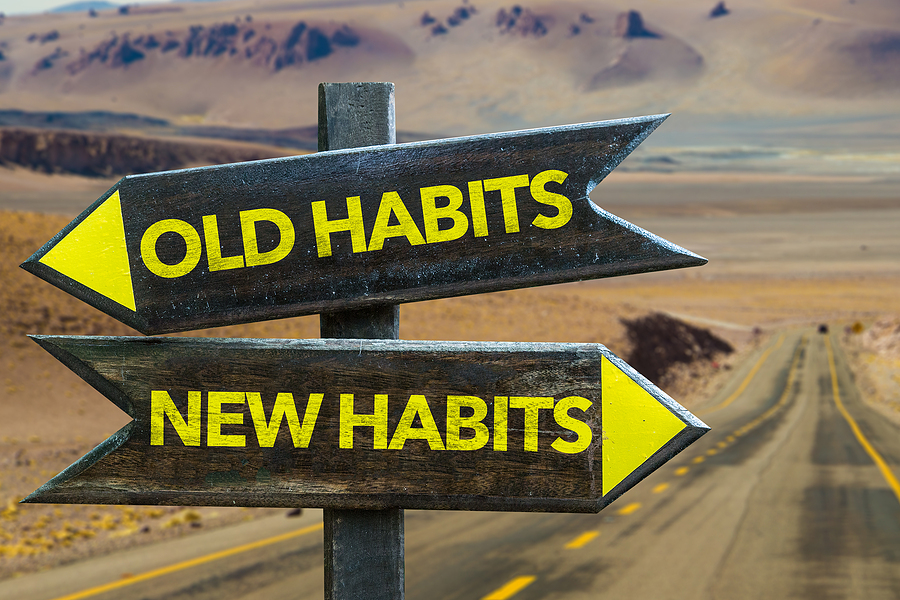 There is power in willingness. I’m talking about more than good intentions here, though that is where it all starts. People are at the threshold of change when the pain of one behavior becomes greater than its payoff. But for that momentum to take hold, the perceived payoff of the change must be greater than the seeming pain of giving something up.
There is power in willingness. I’m talking about more than good intentions here, though that is where it all starts. People are at the threshold of change when the pain of one behavior becomes greater than its payoff. But for that momentum to take hold, the perceived payoff of the change must be greater than the seeming pain of giving something up.
The trouble is you may not really know what that payoff will be. And though you also may not know what that change will entail, your mind will be off and running creating scenarios that have you believing it’ll be far harder than anything you can imagine.
And that can become a real showstopper if you aren’t ready for it.
It’ll keep you from getting out of bed in the morning. It’ll have you playing small when you are on the verge of bold, courageous action. It’ll make the old beaten path you’ve been traveling seem preferable to heading into the uncertainty of whether you will be able to do whatever you are learning to do in place of your old behavior.
So, you have to make a commitment to yourself.
You must get really clear in your mind that you will no longer tolerate your old way of doing things and decide that you will do whatever it takes to move beyond it.
It helps if you write it down. And it also helps if you tell someone else about it – someone who can remind you of all the reasons you are doing it, of what you have to gain, and of what you are rising above and why.
Think about a habit you would like to move beyond.
- How has it been hurting your effectiveness? Your credibility? Your peace of mind?
- What would you gain by rising above it?
- What could you do if you no longer fell into that pattern of behavior?
- How would you feel?
Are you ready to make a change?
If so, make a commitment right now to yourself. Write it down and then share it with someone who will support you as you endeavor to carry that commitment out.
As promised, in coming weeks I’ll continue to deliver to you a five-step process for changing habits that are getting in the way of your success – the impact you can make and the satisfaction and fulfillment you can enjoy both on and off the job.
These steps are a small part of what I teach and coach executives to implement in The Pinocchio Principle Unleashed, a thirteen-week, seven-module virtual leadership development program designed to help business professionals like you maximize your performance, minimize stress and pressure, and enjoy a more fulfilling life both on and off the job (and lead others to do the same).
Next week I’ll share with you the second step to breaking a habit that is hurting you.
Here’s to your success!
Are Your Habits Hurting You?
Often, we don’t seek help until things begin to hurt us. And though it’s unfortunate that we wait until things become painful to try something different – it is often just the springboard we need to find better ways of doing and being.
- Maybe your last temper explosion led people to no longer want to support you, and you are ready to figure out ways of better channeling your anger.
- Maybe you have totally burned yourself out and are starting to realize that there has to be a better way of doing things.
- Or perhaps you’ve finally realized you’re never going to be able to sustain your success and take your game to a new level as a leader of others if you insist on doing everything yourself.
When your habits begin to hurt you, you get to decide what you are going to do about them. It’s a crossroads that can be challenging – because though you might be experiencing pain and discomfort with your habit, it likely will seem as though anything you might need to do differently will be even worse. And that is the root of resistance.
But what I have found through my own experience, as well as that of so many others – friends, clients, colleagues – is that the pain caused by resistance is far worse than anything it would have you avoid.
Maybe you don’t need to wait until it comes to a head.
We all have habits that no longer serve us. And you already likely know what habit (or habits) are bringing you down. So, the question is, what are you going to do about it?
Over the next few weeks, I’ll be walking you through a five-step process for changing the habits that hurt you. It’s a small part of what I teach in the Pinocchio Principle Unleashed, a seven-module virtual leadership development program designed to help business professionals like you maximize your performance, minimize stress and pressure and enjoy a more fulfilling life both on and off the job (and lead others to do the same).
For now, take stock of the things you do on autopilot that may not necessarily be in your best interest – and begin to notice any negative impact those behaviors may be having on your work or in your life. Making needed change in those areas could yield rich dividends. And it all starts with conscious awareness and a willingness to consider doing things differently.
“When we are attentive to our actions, we are not prisoners of our habits.” – T. K. V. Desikachar
But what if you could?

Do you remember what it was like to be unconstrained by the world’s limitations?
Maybe you were a young child, wanting to fly to the moon or discover buried treasure. How long was it before the people around you compelled you to be more “practical and realistic”?
They didn’t mean any harm. In fact, those people likely had your best interests in mind. They wanted to help you learn the rules for engagement in a world of challenges and limitations – to keep you from experiencing pain and disappointment.
Chances are you do that for your own young children. I know I did.
But over time, the rules for engagement can become more constraining than they are empowering. Especially when those rules don’t really apply the way they used to.
Have you noticed that many of the old, ingrained ways of getting things done and achieving success are no longer effective, or even relevant?
We are all experiencing it – on both an individual and a collective level, in our homes, our communities and our organizations. And we need to find a better way of dealing with these emerging challenges and opportunities. To do that, we must transcend old, well-worn, even tried and true methods that just aren’t working anymore.
The time has come for us to access the creativity, ingenuity, curiosity, and wonder of that little kid that knew no limits and had the willingness and determination to blaze a new trail.
As trees and flowers all around us burst into bloom with the emergence of spring, we can allow creative energy and inspiration to move through us as well.
In nature and in our own lives, the old must give way to the new. Trees lose their leaves and flowers and plants that have been pruned proliferate with an energy and vitality that wouldn’t have otherwise been possible.
What old beliefs and assumptions in your life and leadership need to give way to what is blooming within you?
The next time your great idea or inspiration is met with inner skepticism or restraint, notice what you are believing and ask yourself if it’s really true. Stay with it and see if you can find a way around the things that would otherwise stop you in your tracks.
We are all the pioneers and architects of our own lives and now is the time to go beyond what we previously thought was possible and do the things we’ve been capable of all along.
“Nothing else in the world…not all the armies…is so powerful as an idea whose time has come.”- Victor Hugo,
Here’s to your success!
How to Have More Good Days at Work – and at Home
Work. Some days are good, and others not so much… Just like life, right?
Since we spend so many of our waking hours working, it’s likely that a good day at work will spill over into your life after work. Unfortunately, a not-so-good day will do that too.
You can’t always change what comes at you in your professional life, but there are some things you can do to have a better experience of it.
What’s interesting is that improving your experience of work won’t just allow you to enjoy your life more. It can also boost your performance, leading not only to greater satisfaction and fulfillment – but also increased effectiveness and better results.
This week’s video expands on that idea and gives you a simple example of how to have more good days at work – and at home. The audio is a snippet of some opening comments from a previous Pinocchio Principle Unleashed group session.
Though enrollment for the fall program has now closed, the Executive Track (an individualized version that blends the curriculum with 1:1 coaching) is available anytime.
You can also bring the group program into your organization and customize it to meet your unique needs. Get more information or join the waiting list to be notified of the next group session at UnleashtheExtraordinary.com.
We all have plenty of work in our lives. Here’s to putting more life into our work – and watching both grow infinitely richer!
FULL VIDEO TRANSCRIPT
One day when my son was 8 years old, he came home from camp with a riddle. He said, “Pretend you’re in a box with four walls all around you and it’s airtight. There’s no handles and no latches. How do you get out?”
“Hmm, I responded. “I don’t know. I think I would punch my way out.”
He said “No.”
“Okay, then I’d use my legs. I’d kick my way out.”
“No.” He was emphatic.
I thought for a moment. “Hmm. Maybe I’d try to chew my way out.”
He was getting more and more irritated with me. “No.”
I was out of ideas, “I don’t know. I give up. How do you get out?”
“Mom,” he said. “If you’re pretending you’re in a box with airtight walls, the way you get out is you STOP PRETENDING.”
Wow, this from an eight year old.
It’s crept into my thinking several times over the years because I think it’s such a great analogy for what we do.
How Beliefs Can Become Boxes
We have these beliefs…
Have you ever thought about how your belief about work shapes your experience of work? To a large degree, we’re pretty much conditioned to believe that work is not supposed to be fun – that work is something that you do in order to earn a living, pay your bills, feed your family, and be a responsible human being. Work is something that you do and you just get through it.
And living… well, living is what you do after work, right?
It’s part of our societal conditioning. Have you ever noticed that?

You Can Break Out of Your Box
The people who enjoy their work are people who have realized that doesn’t have to be true.
“What if I didn’t think that? What if I approached it differently? What if I thought of work as an opportunity for me to do something cool, to contribute to something bigger than me? What if I thought of work as an opportunity to be around people or to partner with people that I really enjoy, or that are really interesting to me, or that I can learn from? What if I think of work as a way that I can somehow grow?”
What a novel idea.
Work is What You Make It
What’s interesting is that people who believe work is a chore, experience it that way. And they get bogged down, and they have so much to do, and they feel like they’re never going to be able to finish it. And it’s one more thing and everything’s going wrong. And then there’s this and there’s that and they can’t wait to go home.
And that person could be working side by side with somebody who believes – even just for that day, even just for that moment, that work is something different. And they will have a whole different experience. They will tell you something entirely different.
It’s not that they won’t have a whole boatload of work to do. It’s not that they won’t have pressure or deadlines and people relying on them and more to do than there’s time to do.
But there’s something about people who believe different things about work that changes the way they interact with everybody. EVERYBODY.
Learning How to Have More Good Days at Work is About Making a Choice
If you think about the last time you went even just to get a cup of coffee… the difference between somebody taking your order that never makes eye contact with you, that’s having kind of a crappy day, that is kind of wearing it on their body and the way that you feel when they serve you…
…the difference between that and somebody who when you walk in, looks you in the eye and asks you how you’re doing and maybe shares something funny or is genuinely interested in you. And really you can tell that when they ask you how you are, it’s not just part of their script. There’s something about their presence that is with you.
I guarantee you they are having a better day than the other person… not because anything different is going on, but because they made a choice to see work differently.
Make YOUR choice.
For more, visit www.UnleashtheExtraordinary.com
Make the most of your mishaps
We all experience our share of mishaps. But with patience and ingenuity, you can turn those setbacks into springboards. This video provides 3 examples of how it’s done. It marks the last day in the countdown to the kickoff of The Pinocchio Principle Unleashed Fast Track launching on 9/20.It’s an excerpt from one of the video lessons in the program.
If you’re thinking about attending, it’s not too late to register. Get more information and save your seat at UnleashtheExtraordinary.com. For alumni or group enrollment, email us at Support@DianeBolden.com.
